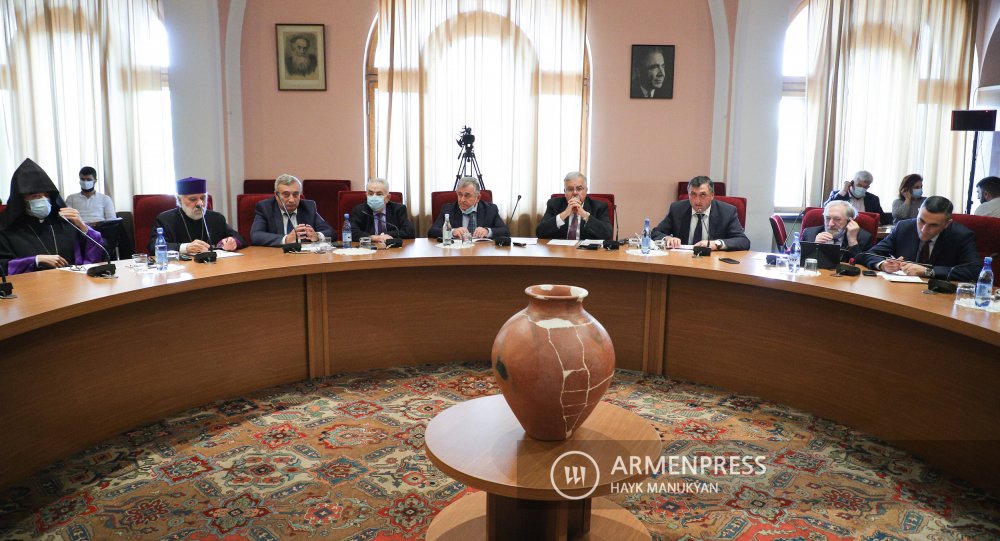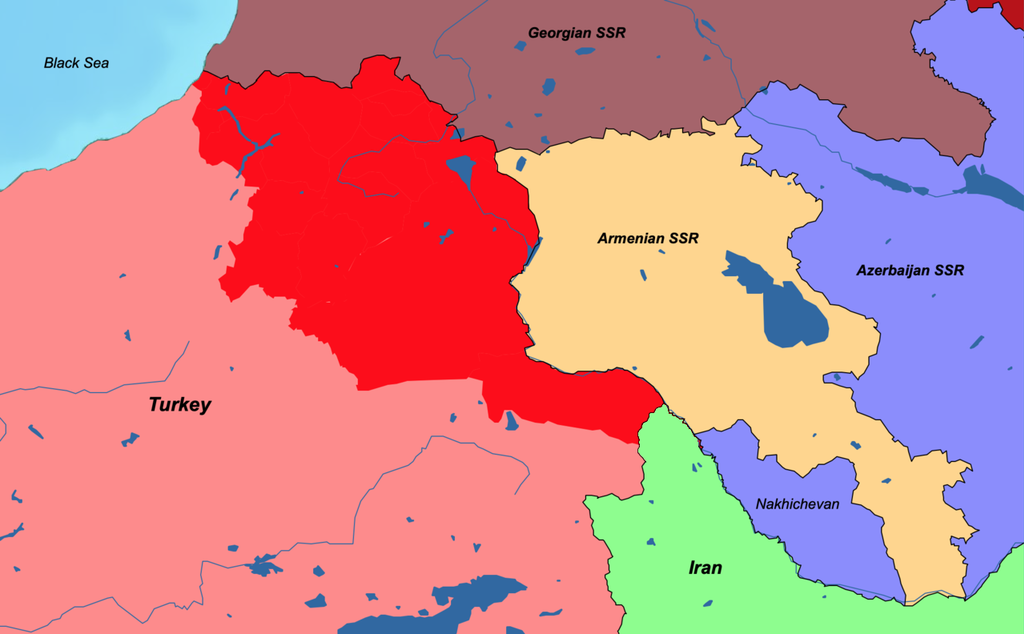The Armenian Weekly
by Yeghia Tashjian
The year 1921 officially put an end to the independence and territorial unity aspirations of the First Armenian Republic—a republic that was squeezed between the Kemalist Turkey and its Tatar agents and the Bolsheviks. On March 16, 1921, the Grand National Assembly of Turkey, headed by Mustafa Kemal Ataturk, and Bolshevik Russia under the leadership of Vladimir Lenin, signed the treaty of “Brotherhood” in Moscow. The treaty had defined the borders between the future Soviet Union (including the three Transcaucasian Republics with Turkey) and the eastern provinces of the emerging Turkish Republic. It is worth mentioning that neither the Republic of Turkey nor the Soviet Union had yet to be established upon the signing of the treaty.
The Kemalists, however, were not satisfied with this treaty, and they demanded a new iteration reaffirming the terms of the Moscow Treaty with the Transcaucasian Soviet republics. Hence, on October 13, 1921, in the fortress of Kars the three Soviet republics of Armenia, Azerbaijan and Georgia recognized Turkey’s boundaries and signed the Treaty of Kars.
Read also
Last month, an international conference was organized in Yerevan titled “Armenia and the Region. Lessons, Evaluations, and Perspectives Dedicated to the Centennial of the Moscow and Kars Agreements (1921)” at the National Academy of Sciences in Yerevan. The conference was organized by the National Academy of Sciences, Institute of Oriental Studies, the Armenian National Committee International and the Research Center of Western Armenian Affairs (Agunk).
There were more than 20 participants, including scholars from Armenia, Russia, the US, Greece, Lebanon and Egypt. The speakers touched on the historic dimensions and circumstances surrounding the signing of these treaties. They analyzed the regional developments and the rapprochement between the Bolsheviks and Kemalists and drew parallels with the events that followed Armenia’s defeat in the 2020 Artsakh War. Turkey’s influence in Africa, the recent Turkish-Russian cooperation and competition in Eurasia and its implications on Armenia were also discussed, as well as the challenges of Armenia’s foreign policy amid post-war regional balance of power.
A Historical and Geopolitical Background of the Treaties
The signing of the two treaties was an outcome of geopolitical shifts in and around the South Caucasus with the emergence of two regional powers that shifted the balance of power and the political landscape of the region.
By the start of 1921, the Bolsheviks emerged victorious from the Russian Civil War. The Bolsheviks were able to win because the Whites (pro-monarchist forces) failed to secure the support of the different national groups, key foreign powers and the peasantry, while the Bolsheviks enjoyed more authority within Russia and were therefore able to assert their power over the Whites. This was something the ARF-led Armenian government couldn’t anticipate. While the Armenian authorities were placing their hopes on Western powers to grant them territories from Western Armenia (later clarified in the Treaty of Sèvres on August 10, 1920), the British and the French were seeking their national interests and securing pacts with the Kemalists to withdraw from the region.
In April 1920, after two years of absence and anarchy in the region, the Russians returned to the South Caucasus through the gates of Baku. Meanwhile, on the ashes of Western Armenians and their ruined territories where they were uprooted, the Turkish nationalist movement was being formed, aiming to maintain the eastern and western borders of the empire. The head of the movement—Mustafa Kemal—and his colleagues were not able to reconcile with the demands signed in the Treaty of Sèvres. As such, they planned to declare war on the Armenians and the Greeks. It was not a coincidence that by April 1920, the 15th Army led by Kazim Karabekir was preparing for war against Armenia.
In the summer of 1920, the geopolitical situation was such that the regional and geopolitical interests of Bolshevik Russia and the Kemalists were quite aligned. These two countries, which were at war against each other a mere three years earlier, now had a common enemy: the Western Allies, the politics of which were a threat to both of them. For the Kemalists, the Western powers were trying to carve Turkey and annex some territories to Armenia and Greece, while for the Bolsheviks, the British were taking control over the oil fields and strategic locations in the Caucasus. There was also an ideological foundation where the Bolsheviks had sworn to struggle against the imperialists and liberate the oppressed and colonized. Mustafa Kemal was clever enough in presenting his national movement as such, which at that stage fell in line with the Bolsheviks’ “anti-imperialist” ideology. Both Bolshevik Russia and Kemalist Turkey were trying everything to expel Western influence from the region. Hence, they believed that the Treaty of Sèvres and the creation of a united Armenia under a Western protectorate was a threat to their vital interests. As the Kemalists pushed forward toward Yerevan and the Bolsheviks pressured Armenia from other directions, the ARF-led authorities surrendered to the Bolsheviks hoping to save the Armenians from another genocide.
As Turkey solved the “Armenian problem” militarily, it sought to secure a “legal guarantee” from the Soviet republics in Transcaucasia and reaffirm its obligations mentioned in the Moscow Treaty. A treaty was signed in the city of Kars on October 13, 1921. Signatories of the Treaty of Kars included representatives from the Grand National Assembly of Turkey and from the Armenian, Azerbaijani and Georgian Socialist Soviet Republics with the participation of the Russian Soviet Federative Socialist Republic. Unlike the other Transcaucasian Soviet republics, the Armenian side ceded more territories to Turkey and its Soviet neighbors and gained much less in return.
The treaty created a new boundary between Turkey and Soviet Armenia, defined by the Akhurian and Araks Rivers. Turkey obtained the territory of the former Kars Oblast of the Russian Empire, including the cities of Kars, Ardahan and Olti, as well as the ruins of Ani. From the former “Erivan Governorate,” it also obtained Surmalu, Mount Ararat, the salt mines of Koghp and the city of Igdir, as well as the Araks corridor, a narrow strip of land between the Araks linking Turkey to Nakhichevan. In exchange, Turkey agreed to cede to Soviet Armenia a small area around Lake Arpi.
According to the memoirs of Simon Vratsian, the last prime minister of the First Armenian Republic, the Bolsheviks attempted to renegotiate the status of Ani and Koghp and to retain them as part of Soviet Armenia. Yakov Ganetsky, who negotiated and signed the treaty on behalf of the three Soviet republics, emphasized the “great historical and scientific value” of Ani for the Armenians and declared Koghp to be an “inseparable part of Transcaucasia.” However, Turkey refused to renegotiate the terms agreed upon in the Treaty of Moscow, much to the disappointment of the Soviets. The Bolsheviks couldn’t analogize Turkey as they thought Ankara was valuable for their “international evolution” against the imperialist forces. Moreover, the Bolsheviks, who just recovered from the civil war, were in no position to challenge the Turks who were gaining an upper hand in the region.
Most of the Armenian territories ceded to Turkey had already been under Turkish military control since the Turkish–Armenian War (September-December 1920). The Treaty of Kars required Turkish troops to withdraw from an area roughly corresponding to the western half of Armenia’s present-day Shirak Province, including the city of Alexandropol (Gyumri). Meanwhile, according to Article V of the treaty, Nakhichevan was going to be an autonomous territory under the protection of Soviet Azerbaijan, “on condition that she (Soviet Azerbaijan) would not cede it to a third party.” In other words, Baku could not return Nakhichevan to Armenia without Turkey’s consent. The creation of the new autonomous republic allowed Azerbaijan to share an 18-kilometer boundary with the Araks corridor, which was now controlled by Turkey.
Hence with the Treaty of Kars, Soviet Armenia was forced to cede more than 50-percent of the territory it controlled before the Armenian-Turkish war and relinquish all claims to the territory it would have gained if the Treaty of Sèvres had been ratified.
As highlighted, the treaty was signed under difficult geopolitical conditions. The Kemalists were able to convince the Russians that if they did not agree on Turkish terms, then Ankara would move towards the west. Hence, the Turks were able to extract maximum concessions from the Russian Bolsheviks, mainly at the expense of weak, defeated and isolated Armenia. It is worth remembering that the Armenian side was not an independent negotiator, and as an outcome of the defeat during the Armenian-Turkish war (1920), the withdrawal of the British from the region, and with the advance of the Bolsheviks, the Armenian side was forced to capitulate on Turkey’s terms.
Assessments and Lessons to be Learned
Different experts and scholars highlighted the historical, legal and political aspects of the treaties that were signed in Moscow and Kars. Some even compared the November 9, 2020 trilateral statement to those treaties. That is, Armenia after a military defeat was once again capitulated and forced to sign such treaties. Others mentioned that we ended up signing such treaties since we committed diplomatic miscalculations, failed to analyze the regional developments and underestimated the enemy. However, all speakers agreed that Armenia must take lessons from these conditions so that we do not end up in similar situations repeatedly.
I would like to summarize the key points and recommendations that were raised during the conference:
The presence of the Turkish troops in Alexandrapol (until late 1921) was to pressure Armenia during the Kars negotiations. Turkey wanted to have a separate agreement with Armenia so that Ankara would guarantee its territorial integrity in the future. The presence of Azeri troops in Armenia proper falls within this context, that is to put additional pressure on Armenia and force her to sign a “peace treaty,” recognizing Azerbaijan’s territorial integrity. Unlike Russia, Georgia and Azerbaijan which have each signed separate agreements with Turkey after 1991, Armenia is seemingly being forced into signing a similar agreement to open borders. This means Armenia will eventually recognize the borders with Turkey according to the Kars Treaty of 1921.
Today history is repeating itself, and non-Armenian scholars are openly talking about Turkey’s pan-Turkic ambitions. Turkey is transforming the Turkic Council into Turkic Unity, and there is a possibility that in the future a union state would be established between Turkey and Azerbaijan similar to the initiatives taken by Russia and Belorussia. Turkey’s foreign policy in the region is becoming aggressive while the Russian, defensive. Turkey has now accomplished what it couldn’t in 1921; having a direct route with the Turkic world through Armenia.
Armenian authorities both during 1920 and 2020 put a lot of weight on Western hope. We thought that the British, French and Americans would prevent the collapse of the First Republic; there were similar hopes during the 2020 war that the international community would stand up for universal values and support the self-determination of the Armenians of Artsakh. This was another miscalculation by the Armenian authorities. If we had succeeded in convincing the Bolsheviks that the annexation of Kars and Ardahan to Armenia was also in their interest, today we would have been in a stronger position. Armenia once again failed to come to an understanding with Russia and find common ground by convincing the Russians that the security of Artsakh is in their interest too.
By now, almost 18-thousand Azerbaijani soldiers and officers have graduated from the Turkish military institutes. Thus, the Azerbaijani army in the future is becoming a Turkish proxy army and being integrated into the Turkish military structure. For this reason, Armenia has to institutionalize its relations with Russia. The only solution for a stable and safe Syunik and Artsakh is to establish demilitarized zones around these regions.
Even though diplomatic backchannels are important and sooner or later the borders with Turkey will open, Armenia must adopt economic protective measures to protect its market from Turkish competitive cheap products. Armenia should avoid becoming another “Adjaria” where Turkey through its soft power (mainly investments) is Turkifying the region and wealthy Turks are buying lands.
During closing remarks, participants drew parallels between the 1920-1921 events and the current situation in the South Caucasus, Armenia’s weak position, the mounting Turkish-Azerbaijani pressures and the dangers of pan-Turkism within the context of the “Zangezur Corridor.” Participants also argued that the Treaty of Kars was a “gross violation of international law” as the independent consent of Soviet Armenia was questionable and both the Grand National Assembly of Turkey and the Bolshevik authorities in Russia were not recognized as states and were “not a subject of international law and, naturally, their government had no authority to enter into international treaties.”



























































